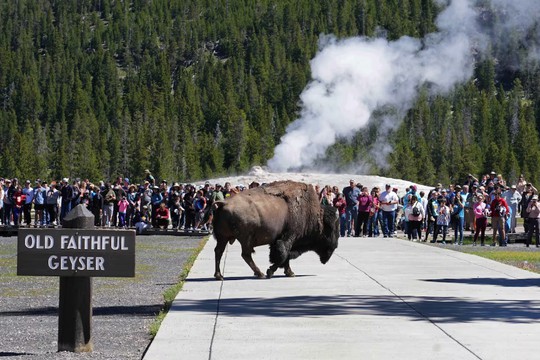A bison walked past a group of people who watched the eruption of Old Faithful Geyser in Yellowstone National Park.
Photo: Getty Images
Magmatic activity deep beneath the Yellowstone Supervolcano may be shifting in a northeasterly direction.
This is the conclusion of a new study by researchers from the United States Geological Survey (USGS) published in ‘The Nature’, which probed the crust beneath Yellowstone National Park and the surrounding area, ‘Newsweek’ writes.
The Yellowstone Caldera — the name refers to the large crater left behind after an eruption — is one of the largest volcanic systems on Earth. It is fed by the "Yellowstone Hotspot," where hot plumes of magma rise from deep within the Earth's mantle.
In the last 2.1 million years, the complex has undergone three major caldera-forming episodes, each of which has erupted hundreds of cubic miles of ash and lava — and many smaller eruptions as well.
According to the team, further research will be needed to determine when the northeastern magma reservoir might erupt.
"Caldera-forming eruptions at Yellowstone are sourced by rhyolitic melts stored within the mid-to-upper crust," the researchers explained in their paper.
Rhyolite is a thick, silica rich magma that flows relatively slowly and can lead to explosive eruptions. In contrast, it is basalt — a more runny and iron/magnesium rich magma type — that wells up from the mantle via the Yellowstone hotspot.
The team's analysis revealed at least seven areas under Yellowstone with a relatively higher magma content — some of which are connected and feed into each other.
These magma bodies lie as deep as 29 miles beneath the caldera and as shallow as just 2.5 miles beneath the surface.
Furthermore, the team's analysis suggests that there could be up to 105 cubic miles of molten rock in the crust beneath northeastern Yellowstone.
In the past 2.1 million years, Yellowstone has had three major eruptions, the most powerful ones in the world’s recorded history and producing enough ash and lava to fill the Grand Canyon. But the last eruption was a small one nearly 70,000 years ago, and the last major one was hundreds of thousands of years before that.
read more in our Telegram-channel https://t.me/The_International_Affairs

 10:41 05.01.2025 •
10:41 05.01.2025 •























